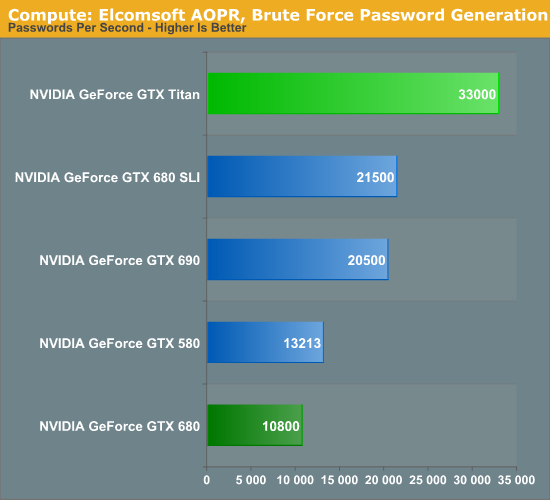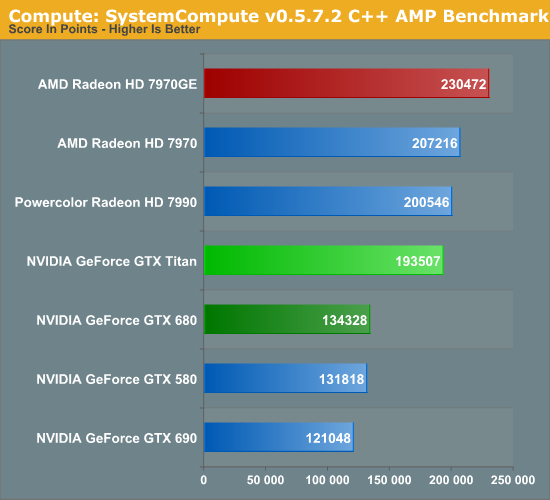NVIDIA’s GeForce GTX Titan Review, Part 2: Titan's Performance Unveiled
by Ryan Smith & Rahul Garg on February 21, 2013 9:00 AM ESTTitan’s Compute Performance, Cont
With Rahul having covered the basis of Titan’s strong compute performance, let’s shift gears a bit and take a look at real world usage.
On top of Rahul’s work with Titan, as part of our 2013 GPU benchmark suite we put together a larger number of compute benchmarks to try to cover real world usage, including the old standards of gaming usage (Civilization V) and ray tracing (LuxMark), along with several new tests. Unfortunately that got cut short when we discovered that OpenCL support is currently broken in the press drivers, which prevents us from using several of our tests. We still have our CUDA and DirectCompute benchmarks to look at, but a full look at Titan’s compute performance on our 2013 GPU benchmark suite will have to wait for another day.
For their part, NVIDIA of course already has OpenCL working on GK110 with Tesla. The issue is that somewhere between that and bringing up GK110 for Titan by integrating it into NVIDIA’s mainline GeForce drivers – specifically the new R314 branch – OpenCL support was broken. As a result we expect this will be fixed in short order, but it’s not something NVIDIA checked for ahead of the press launch of Titan, and it’s not something they could fix in time for today’s article.
Unfortunately this means that comparisons with Tahiti will be few and far between for now. Most significant cross-platform compute programs are OpenCL based rather than DirectCompute, so short of games and a couple other cases such as Ian’s C++ AMP benchmark, we don’t have too many cross-platform benchmarks to look at. With that out of the way, let’s dive into our condensed collection of compute benchmarks.
We’ll once more start with our DirectCompute game example, Civilization V, which uses DirectCompute to decompress textures on the fly. Civ V includes a sub-benchmark that exclusively tests the speed of their texture decompression algorithm by repeatedly decompressing the textures required for one of the game’s leader scenes. While DirectCompute is used in many games, this is one of the only games with a benchmark that can isolate the use of DirectCompute and its resulting performance.
Note that for 2013 we have changed the benchmark a bit, moving from using a single leader to using all of the leaders. As a result the reported numbers are higher, but they’re also not going to be comparable with this benchmark’s use from our 2012 datasets.

With Civilization V having launched in 2010, graphics cards have become significantly more powerful since then, far outpacing growth in the CPUs that feed them. As a result we’ve rather quickly drifted from being GPU bottlenecked to being CPU bottlenecked, as we see both in our Civ V game benchmarks and our DirectCompute benchmarks. For high-end GPUs the performance difference is rather minor; the gap between GTX 680 and Titan for example is 45fps, or just less than 10%. Still, it’s at least enough to get Titan past the 7970GE in this case.
Our second test is one of our new tests, utilizing Elcomsoft’s Advanced Office Password Recovery utility to take a look at GPU password generation. AOPR has separate CUDA and OpenCL kernels for NVIDIA and AMD cards respectively, which means it doesn’t follow the same code path on all GPUs but it is using an optimal path for each GPU it can handle. Unfortunately we’re having trouble getting it to recognize AMD 7900 series cards in this build, so we only have CUDA cards for the time being.

Password generation and other forms of brute force crypto is an area where the GTX 680 is particularly weak, thanks to the various compute aspects that have been stripped out in the name of efficiency. As a result it ends up below even the GTX 580 in these benchmarks, never mind AMD’s GCN cards. But with Titan/GK110 offering NVIDIA’s full compute performance, it rips through this task. In fact it more than doubles performance from both the GTX 680 and the GTX 580, indicating that the huge performance gains we’re seeing are coming from not just the additional function units, but from architectural optimizations and new instructions that improve overall efficiency and reduce the number of cycles needed to complete work on a password.
Altogether at 33K passwords/second Titan is not just faster than GTX 680, but it’s faster than GTX 690 and GTX 680 SLI, making this a test where one big GPU (and its full compute performance) is better than two smaller GPUs. It will be interesting to see where the 7970 GHz Edition and other Tahiti cards place in this test once we can get them up and running.
Our final test in our abbreviated compute benchmark suite is our very own Dr. Ian Cutress’s SystemCompute benchmark, which is a collection of several different fundamental compute algorithms. Rahul went into greater detail on this back in his look at Titan’s compute performance, but I wanted to go over it again quickly with the full lineup of cards we’ve tested.

Surprisingly, for all of its performance gains relative to GTX 680, Titan still falls notably behind the 7970GE here. Given Titan’s theoretical performance and the fundamental nature of this test we would have expected it to do better. But without additional cross-platform tests it’s hard to say whether this is something where AMD’s GCN architecture continues to shine over Kepler, or if perhaps it’s a weakness in NVIDIA’s current DirectCompute implementation for GK110. Time will tell on this one, but in the meantime this is the first solid sign that Tahiti may be more of a match for GK110 than it’s typically given credit for.










337 Comments
View All Comments
CeriseCogburn - Sunday, February 24, 2013 - link
Enlightenment comes slow to the angry activist conspiracist tinfoil hatter, but it appears you've made progress.Another REASON $999 is the correct price.
Suck it up loser.
Sabresiberian - Tuesday, February 26, 2013 - link
You know, there are some reasonable arguments against this card, but you have to take it to an AMD fanboy level by calling it an overpriced GTX 680.iSlayer - Saturday, March 30, 2013 - link
Titan gets pretty close to 690/680 SLI performance while using less power, producing less heat, and freeing up space for 3 additional Titans. With Titan, I can make a machine up to 60% more powerful than was previously possible. Sure, it's going to cost twice as much as it would to get the same performance from other cards, but that's only theoretical as you literally cannot match a Titan config with a single computer.You seem to have entirely missed the point of this card.
klepp0906 - Friday, February 21, 2014 - link
if you thought the titan was a troll, i'd hate to see what you call their latest attempt w/ the titan black, free of the artificial limitations put in place just so they can make another money grab. (all while the driver support on the older card still falls flat on its face in many cases ie: surround)ehpexs - Thursday, February 21, 2013 - link
Nvidia has been so greedy with 600 series. 560s turned into 680s and now this. Nvidia is not getting my money for years.HighTech4US - Thursday, February 21, 2013 - link
> Nvidia has been so greedy with 600 series. 560s turned into 680s and now this. Nvidia is not getting my money for years.So you instead gave your money to greedy AMD and their $549 HD7970 last January or did you wait for AMD to become less greedy when they had to reduce the price by $120 because of the greedy Nvidia releasing the GTX680.
chizow - Thursday, February 21, 2013 - link
Yes AMD started this all with their ridiculous 7970 prices, but Nvidia has taken it way beyond that. $1K is usury, plain and simple.Hrel - Thursday, February 21, 2013 - link
Haha, never seen anyone use the word "usury" in real life before. You used it kinda wrong but your point came across. Nice!chizow - Friday, February 22, 2013 - link
It's contemporary usage has extended beyond the traditional references to loans/interest, if you replace "interest" with "premium" it makes perfect sense. But glad you understood and enjoyed the reference.mlambert890 - Saturday, February 23, 2013 - link
It's a ridiculous usage honestly. The sense of entitlement people have is almost incomprehensible that there is moral outrage over an expensive video card.If you feel its a bad deal, don't buy it. If you feel that somehow NVidia has committed a sin against nature by releasing the 680 originally (which is somehow now being viewed as "broken" I guess.. amazing) and then releasing this card at $1000, because you feel that this card should have *been* the 680, then you are making assumptions without any evidence.
Everyone seems to be basing their angst on the notion that NVidia *could* be selling this card right now at $500. How does *anyone* know this? It's faith based insanity. No one knows what their yields are on this thing yet all of the disgruntled are going out on some wild limb screaming because they feel this card could have come out last year for half price.